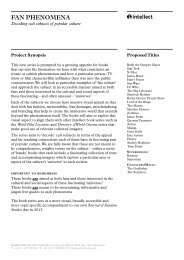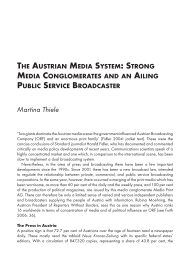Anthem - Intellect
Anthem - Intellect
Anthem - Intellect
Create successful ePaper yourself
Turn your PDF publications into a flip-book with our unique Google optimized e-Paper software.
<strong>Anthem</strong><br />
The more well-known original arrangement made by Herbert von Karajan in 1972<br />
is much more solemn, dark and dense than Guyard’s, with a Romantic nineteenth<br />
century feel, and definitely leaning towards the hymn type rather than the mid-tempo<br />
march that is more prominent in Beethoven’s original setting. 402 Karajan recorded one<br />
vocal version and one with wind orchestra; the latter is in focus here. The tempo is<br />
also considerably slower (115–128 bpm) than in Beethoven’s original version (140–<br />
160 bpm). 403 The total time length of 2’14” (in some versions 2’07”) includes four<br />
introductory bars with the five first notes of the melody performed twice, rising up<br />
against a G major chord; then the 24-bars anthem melody twice in C major, first piano,<br />
then forte with full winds and percussion; and finally a 4 bars coda. The first hymn<br />
performance is presented with soft and quiet woodwinds, the second with louder<br />
percussion and brass instruments added as well. There is no transition in between,<br />
but they follow immediately after one another. The second repetition has some very<br />
slight echoes of Beethoven’s alla Turca version, in the celebratory triangle and flute,<br />
but not at all in any noisy or rough way, rather adding festivitas to the solemn joy this<br />
arrangement expresses. The whole arrangement signals an almost sacrally serious,<br />
ceremonial, officious and pompous art music that seems to invite a reverential<br />
procession and/or communal hymn singing. Karajan’s arrangement thus effectively<br />
downplays the Dionysic element, reinforcing the effect of omitting Schiller’s lyrics.<br />
Some existing 1’00” versions of Karajan’s arrangement only have one verse plus the<br />
coda. There are also other versions with Karajan’s sound, for instance a 2’27” vocal<br />
one where the hymn is after a slightly different introduction repeated three times in<br />
different keys, resulting in a forward-oriented progression with a stepwise release of<br />
tension (F#BGC), and with shifting transitions between each part, probably<br />
intended to increase the climactic progression effect. 404<br />
Different sources thus offer shifting versions of the anthem, but some elements<br />
remain roughly constant, compared to its original symphony setting.<br />
1. All of them place the tune in completely different context, either without any<br />
introduction and ending at all, or sometimes with just a couple of bars of brief<br />
intro and fade-out. Esteban Buch laconically notes that Karajan has made<br />
a kind of cut and paste exercise from Beethoven’s movement, adding a clear<br />
beginning and end to keep it within a strictly confined two minutes format. 405<br />
This decontextualisation cancels every hint of the ode as rising from the ruins<br />
of chaotic aggression that was so crucial for Beethoven as well as for the EU<br />
founding myth discussed in relation to Europe Day above.<br />
2. The musical narrative is linearised, as all musical parameters are accumulated and<br />
heightened with each repetition, leading up to a unique moment of apotheosis<br />
where the anthem simply ends. 406 While Beethoven went through a series of<br />
175












